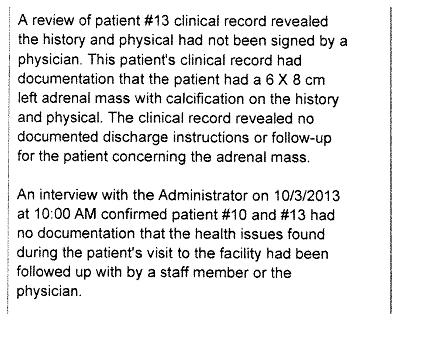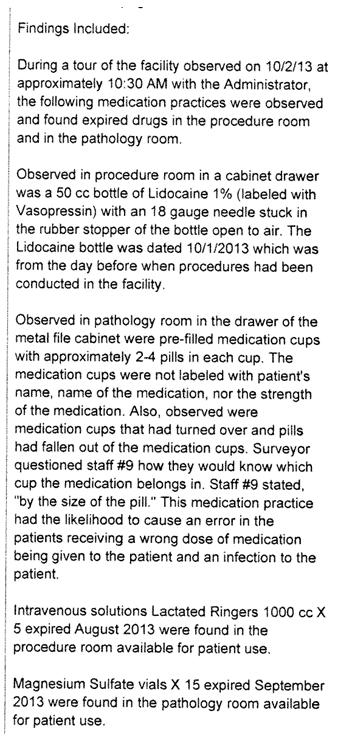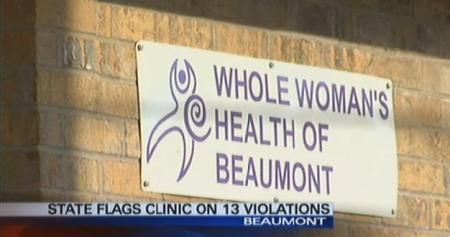Media props up Texas abortion clinic owner with abysmal health code record
Supporters and opponents of the newest Texas abortion law are back in Austin after traveling to New Orleans for arguments in front of the 5th U.S. Circuit Court of Appeals.
The arguments Monday concerned whether the state of Texas can enforce a law that led to the closing of several abortion clinics, a case that ultimately appears bound for the U.S. Supreme Court.
However- the media is very quiet about the conditions at Texas abortion clinics. In fact, one of their favorite go-to gals for comments is Amy Hagstrom Miller the CEO at Whole Woman’s Health, an abortion clinic chain in the state.
Recently one of their centers was inspected and what authorities found was abysmal.
The Dallas Morning News interviewed her and wrote this:
Amy Hagstrom Miller, president of Whole Women’s Health, which operated five abortion clinics before the law went into effect, said that most of the clinics are operating with half the staff. The McAllen clinic is unlikely to ever reopen because of the difficulty obtaining hospital privileges, she said.
“There are thousands of women who are not able to access safe, affordable abortions,” Hagstrom Miller said after the hearing.
She said that while she welcomed some of the questions posed by the judges, “we’ve never had a lot of hope from the 5th Circuit. But we await what’s to be seen.”
But the state said she failed to provide a safe environment for her patients at one of her locations.
According to the report, Whole Woman’s failed to have some of the same life-saving tools on site that Convicted abortionist Kermit Gosnell was cited for in Pennsylvania.
Yet the media continues to prop this woman up.
The Austin Chronicle posted this gem:
“The [DSHS] statement and issuing of rules that ignore thousands of Texans’ comments is shocking in its radical political stance and willful ignorance of medical facts and public opinion,” WWH founder and CEO Amy Hagstrom Miller said in an emailed statement. Taken together, the state argues that the regulations in HB 2 do not “present an undue burden [on women] and argues that Texas women still have a right to make the decision to have an abortion,” she said. “Indeed … women can still decide to terminate a pregnancy, but thousands of them can no longer actually access safe, professional medical care to receive that termination. A right is meaningless if you cannot act on it. Without providers, the right to an abortion is an abstraction that does not exist for thousands of Texas women.”
A few days ago, MSNBC wrote this about Whole Woman’s Health, “In the Rio Grande Valley, Whole Woman’s Health CEO Amy Hagstrom Miller told msnbc, doctors are struggling to care for women who have complications from self-induced abortions. Her clinic there, in McAllen, was one of two in the border region that had to stop performing abortions because of the law’s requirement that abortion providers have admitting privileges at a hospital within 30 miles. “I can’t even get the hospital there to send us an application,” said Hagstrom Miller.”
Recently the pro-choice blog, RH Reality Check, which claims they want Safe and Legal abortion supported Whole Woman’s Health abortion clinic chain despite their health code violations:
RH Reality Blog writes, “One Texas abortion provider said she canceled 45 scheduled abortion procedures Friday morning as a new state law, mandating that abortion-providing doctors have admitting privileges at nearby hospitals, goes into effect following a federal court of appeals ruling handed down Thursday. Amy Hagstrom Miller is the CEO at Whole Woman’s Health, a group of Texas health-care facilities that, until Friday, had been providing abortions at five locations in the state. Now, there are only two Whole Woman’s clinics that staff doctors who have hospital admitting privileges, leaving their clients in Fort Worth, San Antonio, and McAllen to seek safe, legal abortion care elsewhere.”
The pro-choice or should I say radically pro-abort blog fails to mention that this abortion clinic chain was recently inspected and several health code violations were found. In fact, of the three abortion clinics they closed, this one was kept open- WHY?
In October, investigators with the state of Texas cited a Beaumont abortion clinic for 13 health and safety code violations.
Since the ruling, Whole Woman’s Health (WWH) has announced that they could not comply with these new safety standards and are shutting down three of their five facilities.
Mark Crutcher, president of the pro-life organization Life Dynamics, Inc., points out that one of the abortion clinics which WWH will keep open is the Beaumont abortion clinic, saying, “The interesting thing is, they are going to keep the Beaumont facility open – the same one that was just found to be out of compliance with the old standards. Now on the surface, this seems odd. After all, if these people are operating a facility that can’t meet the old lower standards, how are they going to comply with the new higher ones. And my take on it is that the people over at Whole Woman’s Health might know something that we don’t know. Maybe what they know is that the facilities they are closing are even filthier than the one in Beaumont.”
We all know that abortion clinics are the utmost in good care – right? WRONG- I mean, the state has NEVER had to take an action against Whole Women’s before?
 Like this on in 2007
Like this on in 2007
Whole Women’s Health abortion clinic has been investigated by the state read here
A private company claims they found hundreds of patients’ documents and waste thrown in a dumpster at the McAllen abortion clinic . The identities of patients at a health clinic in McAllen may be at risk. An anti-abortion group says they found the trash and documents in a dumpster near Whole Women’s Health of McAllen. It’s now in the hands of the attorney general and Texas Commission on Environmental Quality.
Read more here
Earlier this year Texas Right to Life reported that Fourteen abortion centers were cited as having infractions that violated inspections, yet due to the weakness of the current law, only one was fined by the state. Although many of the violations were recorded, much of the reports was blacked out. Below is a summary of the little that is actually legible:
Read more here
“Whole Woman’s Health and Planned Parenthood want the public to believe that abortion facilities are safe for women. A rusty suction machine, faulty sterilizing fluid, a faulty sterilization machine, holes in the floor exposing the facility to rodents, expired and unlabeled medication, and absent or poorly trained nursing staff contradict the abortion industry’s rhetoric,” said Joe Pojman, Ph.D., executive director of Texas Alliance for Life. “No woman should be exposed to such horrendous conditions. Women deserve better.”
Here is a list of some of the violations of current law cited by DSHS’ inspectors in their reports. (DSHS has redacted information from the reports that identifies staff or patients.) Some violations appears repeatedly over three years of inspections. The most recent inspection was on October 3, 2013, weeks after Hagstrom Miller’s statement.
Whole Woman’s Health of Beaumont, 440 18th Street, Ste A, Beaumont, TX 77703

November 17, 2011
“Based on demonstration and interview the facility failed to ensure the staff was trained in sterilization process of surgical instruments.”
“Staff #2 did not know what a sterilization indicator was or what it is used for in the sterilization process.”
“An interview with the Administrator . . . confirmed there were not sterilization indicators in the facility.”
“[T]he facility failed to staff the clinic with a registered nurse(s) or a licensed vocational nurse(s).”
“[T]he facility administration failed to ensure staff received training, education, and orientation to their specific job description.”
“[T]he facility failed to provide a safe and sanitary environment.”
“[T]here was a drain in the middle of the room, but the cover was loose and caused a hole to be in the floor right in front of the patient’s bed.”
“[I]n procedure room #2 there was numerous rusty spots on the on the suction machine used on the patient” for an abortion.
“[T]he evacuation plan of the building was not posted for the safety of patients and employees.”
“[T]he facility failed to provide safe equipment in the patient’s procedure room.”
“[T]he facility’s staff failed to monitor the expiration dates on sterile supplies.”
“Based on observation and interview the facility failed to maintain the sterility of the surgical instruments.”
“[T]he facility failed to ensure staff was trained in CPR . . .”
“[T]he facility failed to have current emergency medication in the emergency crash cart and follow the facility’s policy.”
“[T]he facility failed to provide emergency airway equipment. This facility provides moderate sedation/analgesia which requires advanced airway management equipment.”
“During the tour of the facility on 11/15/2011 at 3:00 PM observed the three facility’s fire extinguishers were last inspection on March of 2010.”
December 19, 2012
“Based on demonstration and interview the facility failed to ensure the staff was trained in sterilization process of surgical instruments.”
“[T]he facility failed to staff the clinic with a licensed vocational nurse (LVN) that meets the experience requirements according to the facility job description for a licensed vocational nurse (LVN).”
“[F]acility staff members (#2, #4, #6, and #7) failed to perform the correct procedure for the sterilization of the surgical instruments.”
“[F]acility failed to maintain the sterility of the surgical instruments before coming into contact with the sterile field.”
“Interview with the Sterilizer Representative on 12/19/2012 at 10:00 AM at the facility revealed the sterilizer had a gasket leak and the door on the autoclave was not opening properly. Questioned when the safety checks were completed why were these problems not identified? He stated ‘that during the safety check only electrical safety is checked and not the functional checks of the equipment. The functional check is more expensive and the facilities do not want to pay for the functional check.’ ”
“The patient had increased bleeding problem after the abortion procedure had been completed. The patient was transferred by private car to the local hospital. Also a review of the record titled “Complication Log” for the past year of 2012 revealed no documentation of a patient having a bleeding complication after an abortion procedure.”
“The facility failed to follow their own Emergency Medical Protocol for a patient transfer to the hospital.”
October 03, 2013
“[T]he facility failed to provide a safe environment for patients and staff.”
“[T]he facility failed to provide safe and sanitary equipment in the patients’ procedure rooms.”
The “suction machines which were being used on patients” had “numerous rusty spots” which had “the likelihood to cause infection.”
“[O]bservation in the pathology room under the sink revealed a large hole in the cabinet flooring. The hole was approximately 6 inches in diameter and the wood was splintered around the edges. The facility was storing sterilization solutions for cleaning instruments around the hole in the floor. The hole in the flooring had the likelihood to allow rodents to enter the facility and the splintered wood edges could puncture the sterilization solutions.”
“Pre-filled medication cups with approximately 2-4 pills in each cup. The medication cups were not labeled with the patient’s name, name of the medication, nor the strength of the medication. Also, observed were medication cups that had turned over and pills had fallen out of the medication cups. Surveyor questioned staff #9 how they would know which cup the medication belongs in. Staff #9 stated, ‘by the size of the pill.’ This medication practice had the likelihood to cause an error in the patients receiving a wrong dose of medication being giving to the patient and an infection to the patient.”
“The patient’s gestation did not fall within the parameter of the providing physician at this facility.”
“[T]he facility failed to file the post abortion complication call back forms in the patients record.”
“The facility failed to have a policy or procedure for patients being assessed at the facility who had the likelihood of developing health problems that had been discovered during their visit.”
“[P]atient #10 and #13 had no documentation that the heath issues found during the patient’s visit to the facility had been followed up with by a staff member or the physician.”
“[T]he facility failed to have the electrocardiograph monitoring equipment ready if an emergency situation occurred in the facility.”
“The cables to the defibrillator were not connected. The Administrator was observed trying to replace the recording paper in the defibrillator, but was unable to feed the paper correctly into the machine. In an emergency situation this has the likelihood to cause harm to the patient.”
“[T]he facility’s Quality Assurance Committee failed . . . to ensure outdated medication were not available for patient use.”
“Based on record review and interview, the licensed vocation nurse at the facility failed to legibly write her name and credentials on 12 of 29 records reviewed.”
Whole Woman’s Health of Fort Worth, LLC, 1717 S Main St, Fort Worth, TX 76110
March 15, 2011
“The facility had not ensured a safe environment, equipped to protect the health and safety of their clients, in that, they had expired equipment in an operating room. and expired medications in the Medication Area, where these items had been available for client use” The Clinical Director verified that the equipment was expired and “had been available for client use.”
“They had not labeled unidentified liquid used in 2 of 2 operating rooms.”
“2 of 3 areas where sterile supplies were stored contained packages of tenaculums that had been sterilized in the ‘closed’ position.”
“The facility had not ensured all staff providing direct patient care were currently certified in basic life support.”
“The Clinical Director did not have a current CPR” certification.”
Several medications were “not properly stored” and found: “sitting out on the counter top,” “unlocked cabinets,” “unlocked refrigerator,” and “unlocked safe.”
“Personnel at facility were not following proper sterilization procedures” by not correctly labeling sterilized tools.
Whole Woman’s Health of McAllen LP, 802 S Main St, McAllen, TX 78501
September 25, 2012
“No evidence of compliance was provided where noncompliance was identified.”
September 04, 2013
“No evidence of compliance was provided where noncompliance was identified.”
“[T]wo out of seven staff members had expired cardio pulmonary resuscitation (CPR) certification.”
“[P]ersonnel at facility were not following proper sterilization procedures.”
Whole Woman’s Health of San Antonio, 4025 E Southcross Blvd Bldg 5 Ste 30, San Antonio, TX 78222
August 29, 2013
“No evidence of compliance was provided where noncompliance was identified.”
“Based on observations, review of staff training records, and staff interviews Whole Woman’s Health of San Antonio failed to implement and enforce acceptable environmental controls in cleaning and preparing instruments for sterilization.”
“During an inspection of sterile processing area with the clinic administrator at 11:45 a.m. on 8/23/13 staff member # 4 demonstrated the process for receiving, decontaminating, and processing surgical instruments. The demonstration revealed several functions performed in the small room were not distinctly separated and prevented the sequence of moving items from soiled to clean without cross contamination.”
” . . . no evidence of staff training for environmental requirements.”
“[T]he administrator and the director of operations following their own review of the findings revealed they could not provide evidence of compliance with the (sterilization) requirement.”
“. . . Whole Woman’s Health failed to follow manufacturer’s instructions for the effective use of disinfectants to decontaminate or reduce the bio-burden in cleaning instruments prior to sterilization.”
“Upon testing the strength of the cidex the test strip revealed it failed and ineffective for use.”








Leave a comment